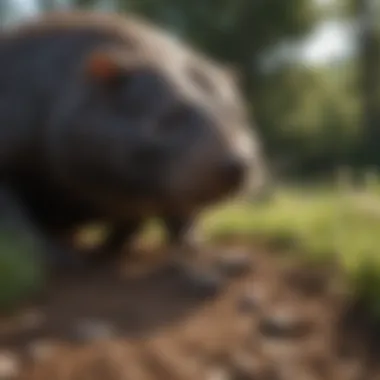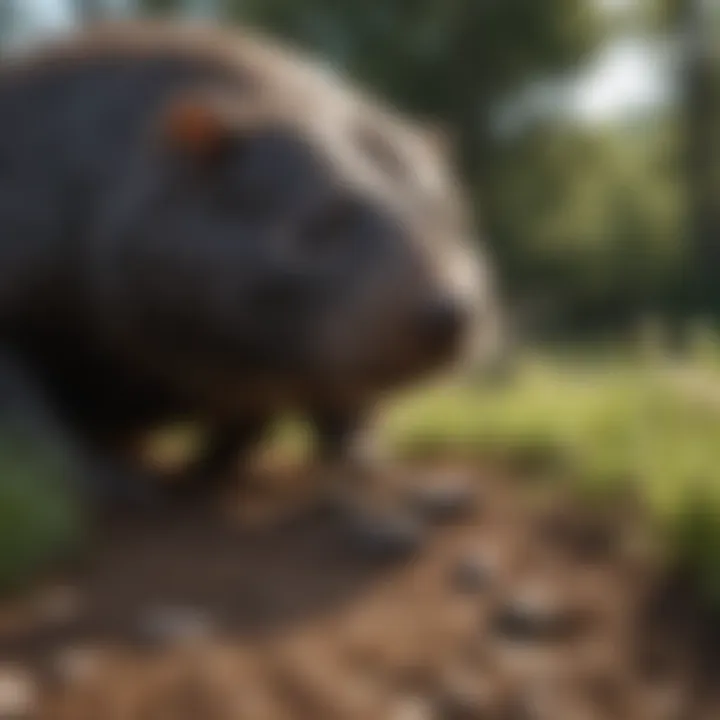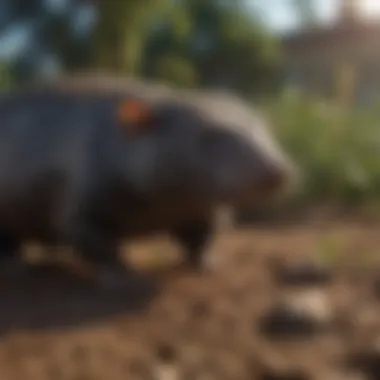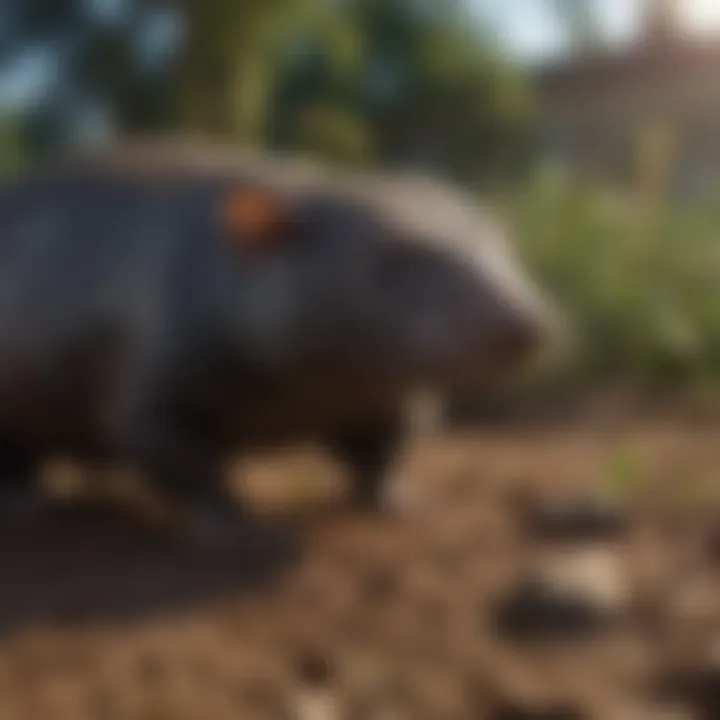Top Strategies for Choosing Yard Mole Repellents


Intro
Dealing with moles in your yard can be challenging. Moles, though often misunderstood, play a role in aerating the soil. However, excessive mole activity can damage gardens and lawns. Hence, finding the right mole repellent becomes crucial for homeowners. In this article, we will discuss effective strategies for selecting the best mole repellent. We will examine various options that range from natural to chemical products. Understanding mole behavior helps in this quest. We will also cover best practices for yard maintenance and dispel common myths surrounding mole management.
Understanding Pests
Understanding pests is vital in effective yard management.
Definition of Pests
Pests are organisms that cause harm to plants, animals, or humans. They can be insects, rodents, or other small animals like moles. Moles are a specific concern for gardens and lawns due to their tunneling habits. While they can be beneficial, too many can disrupt the ecological balance in a yard.
Importance of Pest Identification
Identifying the type of pest is critical for implementing the right control measures. Each species has distinct behaviors, food preferences, and interactions with their environment. For moles, understanding their diet and habits can influence which repellent methods will be most effective. Proper identification also helps avoid unnecessary chemical treatments that may harm other beneficial organisms in your yard.
Prevention Techniques
Prevention is often the best strategy against pests. By making proactive changes in the yard, homeowners can discourage moles from establishing a presence.
Home and Garden Preventative Measures
Taking steps to prevent moles involves a combination of physical barriers and habitat modifications.
- Maintaining healthy soil reduces the population of grubs and earthworms, which attracts moles.
- Creating barriers, such as metal mesh, can inhibit their tunneling.
- Keeping the yard clear of debris decreases potential habitats for moles.
Seasonal Prevention Tips
Knowing when moles are most active can aid in your prevention efforts. Moles tend to be more active in spring, as they search for food sources after winter. During this season, homeowners should inspect their lawns for signs of mole activity. Immediate action helps in minimizing the risk of extensive damage.
Eco-Friendly Pest Control Solutions
Implementing eco-friendly pest control methods aligns with sustainable practices. It’s essential to consider environmental impacts when choosing repellents.
Overview of Sustainable Practices
Sustainable pest control solutions prioritize methods that protect the ecosystem. Using natural repellents can deter moles without harming beneficial species. Methods include utilizing plants that are known to repel moles, such as marigolds.
Natural Remedies and Their Effectiveness
Many natural remedies claim effectiveness for mole control. For instance, castor oil serves as a common repellent. Some homeowners also use castor bean plants due to their natural properties. To apply, mix castor oil with water and spray in areas where moles are seen. However, effectiveness may vary among different yards based on individual conditions.
"Choosing the right mole repellent requires understanding the specific conditions of your garden. The right approach not only helps manage the problem but also ensures a balanced ecosystem."
By using the strategies outlined above and understanding mole behavior, homeowners can select the most appropriate repellent for their yards. This way, they achieve a manageable pest control solution that respects the natural environment while maintaining the beauty of their gardens.
Understanding Moles and Their Behavior
Understanding the behavior and habits of moles is crucial in choosing the right repellent for your yard. Moles are secretive creatures, primarily spending their lives underground. Their inclination to tunnel and burrow can lead to significant disruption in gardens and lawns. Learning about their habitats, feeding patterns, and signs of activity provides essential insight that can guide homeowners in selecting the most effective repellent.
Mole Habitats and Preferences
Moles typically prefer environments that offer moist soil rich in earthworms and insect larvae. They thrive in areas with plenty of moisture because it helps them dig more efficiently. As a result, yards with heavy clay or loamy soils can attract moles more than dry sandy areas. Moles are often active in suburban environments where gardens and lawns provide ample food resources. Some common habitats include:
- Wooded areas: They prefer regions with thick ground cover.
- Gardens: Vegetation attracts insects, fostering a good feeding ground.
- Fields: Farmlands with crops can also be a suitable haven for moles.
Feeding Habits of Moles
Moles are primarily insectivorous. Their diet consists of worms, grubs, and other small invertebrates found underground. They do not feast on roots or plants, which is a common misconception. Their feeding habits are essential for maintaining soil health, as they aerate the soil while searching for food. Moles generally consume their weight in food every day, which shapes their need to keep moving and tunneling. This behavior can lead to a series of tunnels in yards as they search for food, causing noticeable damage over time.
Signs of Mole Activity
Recognizing the signs of mole activity helps homeowners assess whether moles are present in their space. Some key indicators include:
- Mounds and ridges in the ground: The most visible sign is push-up mounds that form when moles excavate tunnels.
- Soft areas in the lawn: As moles dig, they can create soft spots on the lawn, making it easy to collapse under pressure.
- Surface tunnels: These are raised areas of soil where moles have tunneled just below the surface. Observing these structures can aid in understanding the pattern of activity.
Each of these signs carries information that can inform the strategy for repelling moles effectively. By being attentive to these details, homeowners can better choose methods that will work best in their specific yard conditions.
The Importance of Mole Control
Mole control is a vital aspect of maintaining a healthy and productive yard. While moles themselves do not pose a direct threat to humans or pets, their tunneling activities can have significant adverse effects on garden and lawn health. Understanding the importance of controlling these creatures is essential for homeowners who strive to keep their outdoor spaces thriving. This section will highlight the key elements that underscore the urgency of managing mole populations effectively.


Impact on Garden and Lawn
Moles primarily feed on insects and grubs found in soil. Their presence can lead to superficial tunneling, disrupting the root systems of plants. This activity can cause visible damage, such as wilting foliage and stunted growth.
Without proper mole control, the damage may escalate:
- Gardens: Vegetables and flowers can become compromised as moles undermine the plants' foundations. This results in less yield and overall plant health.
- Lawns: Tunneling creates uneven surfaces, leading to potential trip hazards and an aesthetically displeasing landscape. Homeowners may struggle to maintain a verdant and lush lawn under these conditions.
In terms of practicality, a property overrun by moles can become a financial burden. The cost of reseeding, replanting, and potential landscaping repairs can quickly add up, making it crucial to invest in mole repellents or other control measures.
Effects on Soil Health
Moles do play a role in aerating the soil, which is an ecological benefit. However, when these creatures thrive unchecked, they can disrupt the soil structure. As they burrow, they can compress soil layers and remove necessary nutrients from the root zone.
Consider the following effects on soil health due to mole activity:
- Nutrient Depletion: The burrowing can mix soil horizons incorrectly, affecting pH levels and nutrient availability. This can lead to poor plant health over time.
- Water Drainage: Excessive tunneling can alter water drainage patterns. This leads to areas of waterlogging in some spots, while others may dry out too quickly, affecting overall soil moisture balance.
Overall, effective mole control contributes positively not only to aesthetics but also to the sustainability of the yard ecosystem.
"Control measures can not only protect your garden and lawn but also help maintain the balance of soil health necessary for other plants to thrive."
Types of Mole Repellents
Understanding the Types of Mole Repellents is crucial for effectively managing mole populations in residential yards. The options can be broadly categorized into natural, chemical, and electronic solutions. Each type offers distinct benefits and considerations for homeowners. The choice of repellent can depend on various factors including safety, environmental impact, and cost. Homeowners should understand these categories to select the most effective and suitable repellent for their specific needs.
Natural Repellents
Natural repellents are often favored for their environmentally friendly profiles and safety for pets and children. Three prominent natural options include Castor oil, essential oils, and specific plants known to repel moles.
Castor oil
Castor oil is a popular natural remedy known for its effectiveness in repelling moles. Its key characteristic lies in the strong odor and chemical compounds that moles tend to avoid. When applied to areas with mole activity, castor oil disrupts their habitat and encourages relocation. The unique feature of castor oil is that it does not harm beneficial insects or the surrounding environment, which makes it a sustainable choice. However, one disadvantage could be the need for frequent reapplication, especially after heavy rain.
Essential oils
Essential oils, similar to castor oil, are noted for strong scents that deter moles. Some commonly used oils include peppermint, eucalyptus, and tea tree oil. Their beneficial aspect is the aromatic properties, which moles find unpleasant. Using essential oils can also add pleasant scents to your yard, improving the overall atmosphere. However, the challenge with essential oils is their volatility; they may require more frequent applications and diluted mixtures to be effective, which can be a consideration for regular upkeep.
Plants that repel moles
Certain plants have shown potential in repelling moles through their root systems and fragrances. For instance, marigolds, daffodils, and certain herbs are cited for their ability to deter these pests. The main advantage of using plants is that they can enhance the overall aesthetics of your yard while providing a functional role. However, a downfall is that these plants may take time to establish and may need care to maintain their repellent properties.
Chemical Repellents
Moving to chemical repellents, they usually offer a more immediate effect compared to natural options. Homeowners should carefully consider their usage to avoid unintended consequences on the local environment. The main categories of chemical repellents include granular and liquid formulations.
Granular repellents
Granular repellents are easy to apply and commonly used in controlling mole activity. These products often contain potent chemical compounds that disrupt mole activity when they come into contact with it. Their main benefit is the long-lasting effect, as the granules can remain active for an extended period. However, one downside may include the potential risk to non-target species, which makes careful application essential.
Liquid repellents
Liquid repellents offer an alternative to granules, providing more flexible application options. These products can be sprayed directly onto areas with high mole activity, allowing for targeted treatment. One advantage of liquid forms is the ability to cover various surfaces effectively, reaching areas that granular products might miss. Nevertheless, they might require more frequent applications, particularly after rainfall, to maintain effectiveness.
Comparison of effectiveness
A comparison of the effectiveness of natural and chemical products can guide homeowners in their choice. Natural repellents might be safer for the environment but could require more frequent applications. In contrast, chemical repellents can yield faster results but may include risks for beneficial wildlife. Understanding these dynamics can help you choose an appropriate method for managing moles effectively in your yard.
Electronic and Ultrasonic Devices
Electronic and ultrasonic devices represent a modern approach to mole control, offering a non-invasive method to deter these pests. The effectiveness and ease of use are key components in this category.
Operation and effectiveness
These devices often work by emitting sound waves or vibrations that are undetectable to humans but irritating to moles. Such a feature makes them unique as they provide a continuous deterrent, which is less labor-intensive than traditional methods. However, effectiveness can vary based on the soil composition and other environmental factors, and some homeowners may see mixed results.
Placement considerations
Placement is a significant aspect of deploying these devices effectively. They need to be positioned strategically, often in areas of high mole activity. Understanding the layout of your garden when installing these devices can enhance their effectiveness. If placed incorrectly, the devices may not yield the desired outcome, thus necessitating trial and error.
Cost analysis


Cost analysis is an important consideration for homeowners choosing among various mole control options. While electronic devices may represent a higher upfront investment, they can provide long-term savings as they can potentially eliminate the need for frequent purchases of other types of repellents. The durability and efficacy over time should weigh against the initial costs when deciding.
By understanding the different types of mole repellents and their unique features, homeowners can make informed decisions that align with their yard management goals.
Application Techniques for Mole Repellents
The selection and proper application of mole repellents are essential for effective pest management in your yard. Different techniques can significantly influence the success rate of repelling moles. By understanding these methods, you can enhance the effectiveness of the chosen repellent and ensure the long-term health of your yard. Proper application not only maximizes the efficacy of the repellent but also minimizes negative impacts on the surrounding environment.
Pre-Application Considerations
Assessing mole activity
Assessing mole activity is critical. It involves observing the signs of moles in your yard, such as raised tunnels and surface ridges. Identifying active areas helps you focus your efforts where they will be most effective. This approach can lead to higher success rates with less product and minimal disturbance to other areas. A central feature of assessing mole activity is timing; early detection allows for proactive measures. The downside can be the time needed to monitor and assess consistently, but the benefits often outweigh this effort.
Choosing appropriate location
Choosing the right location for application is equally important. Proper placement of a repellent can influence its immediate effectiveness. This involves selecting areas where moles are most active, typically near food sources like grubs or worms. The key to choosing a location is understanding mole behavior and habitat preferences. A unique advantage is that targeting specific areas reduces waste and minimizes the repellent's overall environmental impact. Improper placement, however, might lead to ineffective treatment, showcasing the necessity of strategic planning.
Application Methods
Spreaders for granular products
Using spreaders for granular products streamlines the application process. They allow for an even distribution of product, ensuring that the repellent reaches the desired areas effectively. The consistency of application is a significant advantage, as uneven spread might lessen the repellent's effectiveness. Additionally, spreaders can cover larger areas in less time compared to manual application. However, they require careful adjustment to suit different granule sizes, which can be a minor drawback if not managed properly.
Liquid application techniques
Liquid application techniques are another method worth considering. They often provide deeper penetration into the soil and can be particularly effective for certain types of repellents. The key characteristic of liquid applications is their ability to bind with the soil, which can enhance the repellent's longevity. It's crucial to follow manufacturer instructions on dilution rates and methods. On the downside, liquid applications might necessitate additional equipment like sprayers, which could increase the complexity of the application process.
Using electronic devices
Using electronic devices represents a modern approach in repelling moles. These devices emit ultrasonic sounds that are displeasing to moles but typically inaudible to humans. Their ease of use is a significant advantage; simply placing them in the ground can deter moles without chemicals. Furthermore, electronic devices often have no chemical residues, making them an appealing option for environmentally conscious homeowners. A potential disadvantage is their reliance on electricity or batteries, which may limit their placement or effectiveness over time.
Frequency of Application
The frequency of application plays a critical role in maintaining effective mole repellent strategies. Regular monitoring and reapplication based on observed mole activity ensure that repellents remain effective. Different products may have varied guidelines, and adherence to those recommendations is crucial. Moreover, seasonal changes can influence mole behavior, necessitating adjusted application frequencies. In summary, integrating these application techniques into your pest management plan can significantly affect the presence of moles in your yard.
Environmental Considerations
Environmental considerations play a crucial role in selecting mole repellents for yards. Homeowners must understand how their pest control choices affect not just moles, but also the broader ecosystem. Responsible use of repellents can mitigate negative impacts on non-target species, enhance soil health, and promote sustainable pest management practices. By considering the environment, homeowners can make informed decisions that contribute to a healthier yard and community.
Impact on Non-Target Species
Effects on beneficial insects
When choosing mole repellents, the effects on beneficial insects cannot be overlooked. Many insects, such as bees and ladybugs, are essential for pollination and pest control. The main concern with certain repellents is their potential to harm these insects instead of helping them.
Using natural repellents can minimize risks. For example, castor oil is often regarded as safe for beneficial insects while still deterring moles. The specific aspect of these effects highlights the need to opt for alternatives that do not disrupt beneficial insect populations. This is an increasingly popular choice among environmentally conscious homeowners. It fosters a balanced ecosystem while addressing the mole problem effectively.
However, some chemical repellents may have broader impacts. They can inadvertently kill non-target insects, which can lead to a decline in essential pollinators and disrupt the food chain. Homeowners should therefore weigh the advantages of effective mole control against the potential disadvantages to beneficial insect communities.
Consequences for wildlife
Considering wildlife is another critical aspect of mole control. The consequences can vary widely depending on the repellent chosen. Chemical repellents, while effective, might pose risks to local wildlife. This can include unintended harm to birds, small mammals, and even pets. Chemicals in certain repellents can contaminate soil and water, affecting species far beyond moles.
In contrast, natural repellents often present less risk to wildlife. They tend to break down more easily in the environment, reducing the chance of harmful build-up. This characteristic makes them a beneficial choice in maintaining ecosystem integrity. The unique feature here is the balance achieved between effective mole control and protecting the habitat. Homeowners can opt for these methods to foster a safer environment.
Sustainable Pest Management Practices
Integrating with other control strategies
Integrating mole repellent efforts with other control strategies can enhance effectiveness while maintaining environmental health. This involves using a combination of repellents, trapping methods, and landscape management practices. This multi-faceted approach helps ensure that moles are kept at bay while minimizing harm to non-target species.
A key characteristic of integration is a holistic view of pest management. This allows for monitoring of mole activity and response based on changing conditions. It is a beneficial approach because it promotes adaptability within gardens and yards. Homeowners can address the root causes of mole issues, such as soil compaction or inadequate drainage, which can contribute to mole attraction.
The integral feature of combining strategies allows homeowners to assess effectiveness regularly, adjusting practices as needed. However, it does require consistent monitoring and assessment, which some may find challenging. Still, the long-term benefits often outweigh the initial efforts.
Long-term solutions for yard health
Long-term solutions are essential for maintaining healthy yards that naturally deter moles. This includes practices such as improving soil health, managing moisture levels, and maintaining a robust plant diversity in gardens. Focusing on yard health creates an environment less attractive to moles.
The key characteristic of long-term solutions is the emphasis on prevention. By addressing soil conditions and promoting beneficial plants, homeowners can create a landscape that resists invasions by moles. This practice not only deters moles, but also supports a thriving garden ecosystem. It's a popular choice as it aligns with sustainable gardening practices.


Additionally, the unique feature of implementing these solutions lies in their cumulative benefits. Over time, improved soil health and diverse plant life can lead to resilient landscapes. However, the challenge can be in maintaining these practices, making it vital for homeowners to stay informed and engaged over the long haul.
In summary, understanding the environmental considerations when selecting mole repellents is crucial for maintaining a healthy yard. This includes being mindful of non-target species, integrating pest management practices, and focusing on long-term solutions for yard health.
Common Misconceptions about Mole Control
In the realm of gardening and yard maintenance, misconceptions about mole control can lead to ineffective practices and frustration. Understanding these myths is crucial for homeowners aiming to effectively manage mole populations. This section highlights common beliefs that may not hold true, and it emphasizes the significance of informed decision-making in pest management.
Myths about Natural Repellents
Many people believe that natural repellents, such as castor oil or essential oils, provide foolproof solutions against moles. While these products can have some efficacy, their effectiveness often varies and is not absolute. For example, castor oil may repel moles temporarily, but it does not eliminate the problem. Some homeowners may apply these natural methods, expecting immediate and complete control, only to find persistent mole activity.
Moreover, the perception that natural repellents are entirely safe is somewhat misleading. These products may still affect beneficial insects and disrupt the ecological balance in the yard. It's essential to recognize that relying solely on natural methods could lead to more extensive damage if moles continue to burrow and create tunnels beneath the surface.
"Natural repellents can play a role, but they should complement other methods of mole control, not replace them."
Misunderstanding Chemical Products
Chemical repellents often come with a reputation for being harsh or harmful, leading to aversions among homeowners. However, the misunderstanding lies in the belief that all chemical products are equally dangerous. Not all chemical repellents are created equal, and many are designed with safety in mind. They can effectively deter moles while posing minimal risk to non-target species when used correctly.
It is important to understand the variety of chemical repellents available. Products such as granular and liquid repellents are specifically formulated to target moles without impacting the surrounding environment. Misusing or over-applying these products can lead to negative consequences. Therefore, homeowners should be aware of the proper application techniques and the importance of following label instructions. This can mitigate potential risks associated with chemical use while enhancing the overall effectiveness of mole control strategies.
Maintaining a Healthy Yard to Deter Moles
Maintaining a healthy yard is vital in deterring moles. A well-managed outdoor space creates an environment less inviting to these pests. Moles are attracted to fertile, moist soil and an abundance of insects. Therefore, if you can modify these conditions, you can substantially reduce the likelihood of moles setting up their tunnels and nests.
One effective approach is regular lawn care. This not only keeps your yard aesthetically pleasing but also impacts the soil quality. Healthy lawns are less prone to pests. Proper soil fertility and management lead to grass that deters mole activity.
Additionally, creating barriers can disrupt mole movement significantly. Structures like fencing or specific landscaping choices can restrict their access to your yard. Collaborative strategies amplify your efforts in managing moles and improve overall lawn health.
Proper Lawn Care Techniques
Regular mowing habits
Regular mowing directly contributes to the overall health of your yard. It keeps grass at ideal heights, making it harder for moles to navigate the lawn undetected. An even, well-maintained lawn is less attractive to them compared to overgrown areas. High grass provides cover and shelter for these pests, so maintaining a shorter grass height can be crucial. This makes regular mowing not only a good practice but a strategic one.
Key benefits of regular mowing include improved air circulation and sunlight exposure, which enhances the health of grassroots. Additionally, it can prevent the lawn from becoming too fertile, reducing the food supply for underground insects that moles feed on. Thus, adopting systematic mowing habits can discourage mole presence.
Fertility management
Fertility management plays a significant role in your yard's ecosystem. It's essential to monitor soil nutrients to enhance your lawn’s health effectively. Over-fertilization can lead to lush, irresistible habitats for moles. Instead, aim for a balanced nutrient supply that encourages healthy grass but not an alarming growth of insects.
The critical aspect of fertility management is testing your soil. Understanding pH and nutrient levels allows you to make informed decisions. The unique feature of proper fertility management lies in its preventive nature. By carefully managing soil health, you can create conditions unfavorable for moles without resorting to chemical controls.
Creating Barriers and Disruptions
Creating physical barriers and disruptions can effectively deter moles. These methods hinder their ability to invade your space and create tunnels where they wish.
Physical barriers
Physical barriers are an immediate form of protection. Installing underground fencing or barriers constructed from metal mesh around the border of your yard can prevent moles from digging through. The depth of installation should be considered, as moles can tunnel quite deep, sometimes up to a foot underground.
The effectiveness of physical barriers lies in their longevity. Once established, they require minimal maintenance and provide lasting protection. However, their distinct disadvantage is the initial effort and costs of setup.
Altered drainage patterns
Altering drainage patterns addresses the habit of moles that thrive in moist soil conditions. By redirecting water flow or improving drainage, you can create drier environments that are less appealing to moles. Adjusting the landscape to include more dry areas disrupts their habitat.
This strategy offers the added benefit of improving lawn health overall. However, care must be taken to ensure that changing the drainage patterns does not lead to water pooling, which could attract other pests instead. Consider the whole ecosystem when making such changes.
The End and Recommendations
Understanding how to effectively choose a mole repellent is essential for maintaining a healthy yard. This section synthesizes the main ideas discussed throughout the article while providing actionable recommendations for homeowners. Selecting the right mole repellent involves careful consideration of the types available, their application methods, and environmental impacts. By following the suggested strategies, homeowners can significantly reduce mole activity and protect their gardens and lawns.
Summarizing Effective Strategies
The key to controlling moles lies in a multi-faceted approach. Here are some effective strategies to keep in mind:
- Identify Mole Activity: Conduct an assessment of your yard to determine areas with high mole activity. Look for signs like raised tunnels or fresh soil.
- Choose Appropriate Repellents: Consider both natural and chemical options. Natural repellents such as castor oil or specific essential oils may be less harmful to the environment.
- Apply Wisely: Follow the application methods provided by the repellent’s manufacturer. Opt for liquid or granular methods based on your preference and the particular product’s instructions.
- Monitor and Adjust: After application, observe changes in mole activity. If necessary, adjust your approach or try alternative repellents.
Keeping these strategies in mind will enhance your yard’s resilience against moles, promoting a better environmental balance.
Long-Term Management and Monitoring
Long-term mole management is not a one-and-done solution; it requires ongoing attention and adjustment. Here are important aspects to consider:
- Regular Monitoring: Keep an eye on your yard even after applying repellents. Early detection of mole activity can prevent larger infestations.
- Yard Health: Maintain a healthy lawn by implementing proper care techniques. Healthy soil and grass can deter moles seeking food and habitat.
- Community Awareness: Engage with local gardening communities or forums such as Reddit. Sharing experiences and solutions with others can provide new perspectives and strategies.
By continually managing your yard and staying informed about mole behavior, a sustainable and effective deterrent strategy can be achieved.



